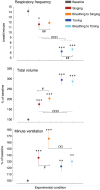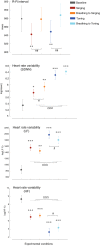Cardiorespiratory optimization during improvised singing and toning
- PMID: 28808334
- PMCID: PMC5556092
- DOI: 10.1038/s41598-017-07171-2
Cardiorespiratory optimization during improvised singing and toning
Abstract
We evaluated the effect of different forms of singing on cardiorespiratory physiology, and we aimed at disentangling the role of breathing from that of vocal production. Cardiorespiratory recordings were obtained from 20 healthy adults at rest and during: a) singing of familiar slow songs as in the standard form of Western culture; b) improvised vocalization of free vowel sounds, known as toning. To disentangle the role of breathing from that of vocal production, we compared the vocal conditions with matched breathing-only conditions. Toning significantly improved heart rate variability, ventilatory efficiency and slowed respiration to almost exactly six breaths per minute (p < 0.001), a pattern that is known to optimize cardiovascular function and that coincides with the period of endogenous circulatory rhythms. Singing songs also positively impacted cardiorespiratory function, although to a lesser extent. The breathing pattern imposed upon participants in the absence of vocal production was sufficient to generate the physiological benefits. The effects of toning are similar to what has been previously described as a result of engaging in formal breathing exercises. Toning and singing may offer an engaging and cost effective tool to trigger beneficial respiratory patterns and the related cardiovascular benefits.
Conflict of interest statement
The authors declare that they have no competing interests.
Figures


References
-
- Stegemöller EL, Radig H, Hibbing P, Wingate J, Sapienza C. Effects of singing on voice, respiratory control and quality of life in persons with Parkinson’s disease. Disabil Rehabil. 2016;10:1–7. - PubMed
Publication types
MeSH terms
LinkOut - more resources
Full Text Sources
Other Literature Sources

